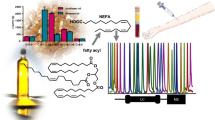Abstract
The existing protocols for analyzing fatty acid methyl esters (FAMEs) using a one-step acetyl chloride (AC) catalyzed transesterification and extraction procedure cannot accurately determine the medium- and long-chain fatty acids simultaneously in clinical (enteral, parenteral) formulations. For example: (1) addition of AC at room temperature generates an exothermic reaction that often results in loss of sample and possible injury to the analyst; (2) certain polyunsaturated fatty acids (PUFAs) are less stable at elevated temperatures during the transesterification and contribute to the over-estimation of the C16:0 and C18:1 fatty acids; and (3) the flame-ionization detector (FID) response varies depending on the carbon chain length of the fatty acids, that consequently impacts the underestimation of medium-chain fatty acid (C6–C10) recoveries. To overcome these deficiencies and accurately determine FAMEs, we have developed an improved one-step transesterification method that employs the addition of AC in tubes kept on a dry ice bath, the transesterification at room temperature, and the data analysis using relative response factors. Using this modified protocol, we determined the fatty acid composition of lipid emulsions (Omegaven® and Lipidem®) on a Shimadzu GC2010 gas chromatography (GC) system using a capillary GC column (Zebron ZB-WAX plus, 30 m, 0.25 mm ID, 0.25 μm). Our data suggest that the improved method can be easily used to accurately determine fatty acids (C6–C24) in functional foods and lipid emulsions.



Similar content being viewed by others
Abbreviations
- AC:
-
Acetyl chloride
- AOAC:
-
Association of Analytical Chemists
- Calc.:
-
Calculations
- Exp:
-
Experimental
- FAME:
-
Fatty acid methyl esters
- FAs:
-
Fatty acids
- FID:
-
Flame ionization detector
- GC:
-
Gas chromatography
- IS:
-
Internal standard
- PUFAs:
-
Polyunsaturated fatty acids
- REF:
-
Relative response factor
- Theo:
-
Theoretical
References
Lagerstedt SA, Hinrichs DR, Batt SM, Magera MJ, Rinaldo P, McConnell JP (2001) Quantitative determination of plasma C8–C26 total fatty acids for the biochemical diagnosis of nutritional and metabolic disorders. Mol Genet Metab 73:38–45
Eder K (1995) Gas chromatographic analysis of fatty acid methyl esters. J Chromatogr B Biomed Appl 671:113–131
Shantha NC, Napolitano GE (1992) Gas chromatography of fatty acids. J Chromatogr 624:37–51
Nota G, Naviglio D, Romano R, Sabia V, Musso S (1998) Evaluation and improvement of transesterification methods of triglycerides. Anal Lett 31:2499–2512
Holman RT, Johnson SB, Mercuri O, Itarte HJ, Rodrigo MA, De Tomas ME (1981) Essential fatty acid deficiency in malnourished children. Am J Clin Nutr 34:1534–1539
Schreiner M (2005) Quantification of long chain polyunsaturated fatty acids by gas chromatography. Evaluation of factors affecting accuracy. J Chromatogr A 1095:126–130
Masood A, Stark KD, Salem N Jr (2005) A simplified and efficient method for the analysis of fatty acid methyl esters suitable for large clinical studies. J Lipid Res 46:2299–2305
Lepage G, Roy CC (1984) Improved recovery of fatty acid through direct transesterification without prior extraction or purification. J Lipid Res 25:1391–1396
Lepage G, Roy CC (1986) Direct transesterification of all classes of lipids in a one-step reaction. J Lipid Res 27:114–120
Fournier V, Destaillats F, Juaneda P, Dionisis F, Lambelet P, Sebedio JL et al (2006) Thermal degradation of long-chain polyunsaturated fatty acids during deodorization of fish oil. Eur J Lipid Sci Technol 108:33–42
Ulberth F, Gabernig RG, Schrammel F (1999) Flame-ionization detector response to methyl, ethyl, propyl, and butyl esters of fatty acids. J Am Oil Chem Soc 76:263–266
Ackman RG, Sipos JC (1964) Application of specific response factors in the gas-chromatographic analysis of methyl esters of fatty acids with flame ionization detectors. J Am Oil Chem Soc 41:377–380
Bannon CD, Craske JD, Hilliker AE (1986) Analysis of fatty acid methyl esters with high accuracy and reliability. V. Validation of theoretical relative response factors of unsaturated esters in the flame ionization detector. J Am Chem Soc 63:105–110
Ulberth F, Schrammel F (1995) Accurate quantitation of short-, medium-, and long-chain fatty acid methyl esters by split-injection capillary gas-liquid chromatography. J Chromatogr A 704:455–463
Olsson U, Kaufman P, Herslof BG (1990) Multivariate optimization of a gas–liquid chromatographic analysis of fatty acid methyl esters of blackcurrant seed oil. J Chromatogr 505:385–394
Eder K, Reichlmayr-Lais AM, Kirchgessner M (1991) Gas chromatographic analysis of fatty acid methyl esters: avoiding discrimination by programmed temperature vaporizing injection. J Chromatogr 588:265–272
Albertyn DE, Bannon CD, Craske JD, Hai NT, O’Rourke KL, Szonyi C (1982) Analysis of fatty acid methyl esters with high accuracy and reliability. I. Optimization of flame-ionization detectors with respect to linearity. J Chromatogr 247:47–61
Bannon CD, Craske JD, Felder DL, Garland IJ, Norman LM (1987) Analysis of fatty acid methyl esters with high accuracy and reliability. VI. Rapid analysis by split injection capillary gas–liquid chromatography. J Chromatogr 407:231–241
Schreiner M, Hulan HW (2004) Determination of the carbon deficiency in the flame ionization detector response of long-chain fatty acid methyl esters and dicarboxylic acid dimethyl esters. J Chromatogr A 1045:197–202
Slemr J, Slemr F, D’Souza H, Partridge R (2004) Study of the relative response factors of various gas chromatograph-flame ionisation detector systems for measurement of C2–C9 hydrocarbons in air. J Chromatogr A 1061:75–84
Cunniff P (1995) AOAC official method 991.04 DDT in technical products and pesticide formulations. AOAC International, Gaithersburg
Armenta RE, Scott SD, Burga AM, Radianingtyas H, Barrow CJ (2009) Optimization of fatty acid determination in selected fish and microalgal oils. Chromatographia 70:629–636
Sonnichsen M, Muller BW (1999) A rapid and quantitative method for total fatty acid analysis of fungi and other biological samples. Lipids 34:1347–1349
Acknowledgments
The work presented in this manuscript is supported by a grant from Baxter Healthcare Corporation. Deerfield, IL 60015, USA.
Author information
Authors and Affiliations
Corresponding author
About this article
Cite this article
Xu, Z., Harvey, K., Pavlina, T. et al. An Improved Method for Determining Medium- and Long-Chain FAMEs Using Gas Chromatography. Lipids 45, 199–208 (2010). https://doi.org/10.1007/s11745-009-3382-7
Received:
Accepted:
Published:
Issue Date:
DOI: https://doi.org/10.1007/s11745-009-3382-7




